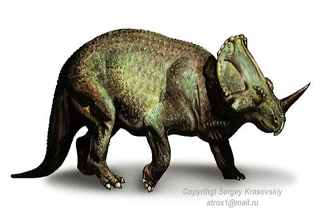
Monoclonius Dinosaur is a genus of herbivorous dinosaur that lived during the late Cretaceous period, approximately 75 million years ago. It belongs to the family Ceratopsidae, which includes other famous horned dinosaurs like Triceratops. Monoclonius was a medium-sized dinosaur, measuring about 6 to 7 meters (20 to 23 feet) in length and weighing around 2 to 3 tons.
The most distinctive feature of Monoclonius was the large frill on the back of its skull, which extended outwards and upwards. This frill was adorned with numerous small bony knobs and spikes, giving the dinosaur a formidable appearance. It also possessed a single horn on its nose, hence its name, which means "single sprout." The horn was relatively short compared to other ceratopsians.
Monoclonius Facts :
| Name: | Monoclonius Dinosaurs |
| Size: | 6 to 7 meters |
| Main Facts: | Monoclonius is a genus of herbivorous dinosaur that lived during the late Cretaceous period, approximately 75 million years ago. |
Monoclonius had a robust body supported by four sturdy legs, which ended in hooves. Its tail was long and muscular, providing balance and serving as a counterweight to its head and frill. Like other ceratopsians, it had a beak-like mouth at the front of its head, which it used to crop vegetation. As a herbivore, Monoclonius likely fed on a variety of low-lying plants, such as ferns, cycads, and conifers. Its teeth were adapted for chewing plant material efficiently.
Monoclonius likely lived in herds, as indicated by fossil evidence showing multiple individuals found together. This social behavior may have provided protection against predators like Tyrannosaurus rex, which coexisted with Monoclonius during the late Cretaceous. Its frill and horn may have served as defensive features, intimidating potential threats or engaging in intraspecific combat during mating season. Fossil remains of Monoclonius have been found in North America, primarily in regions such as Montana, Alberta, and Wyoming. These discoveries have contributed significantly to our understanding of ceratopsian dinosaurs and the ecosystems they inhabited during the late Cretaceous period.